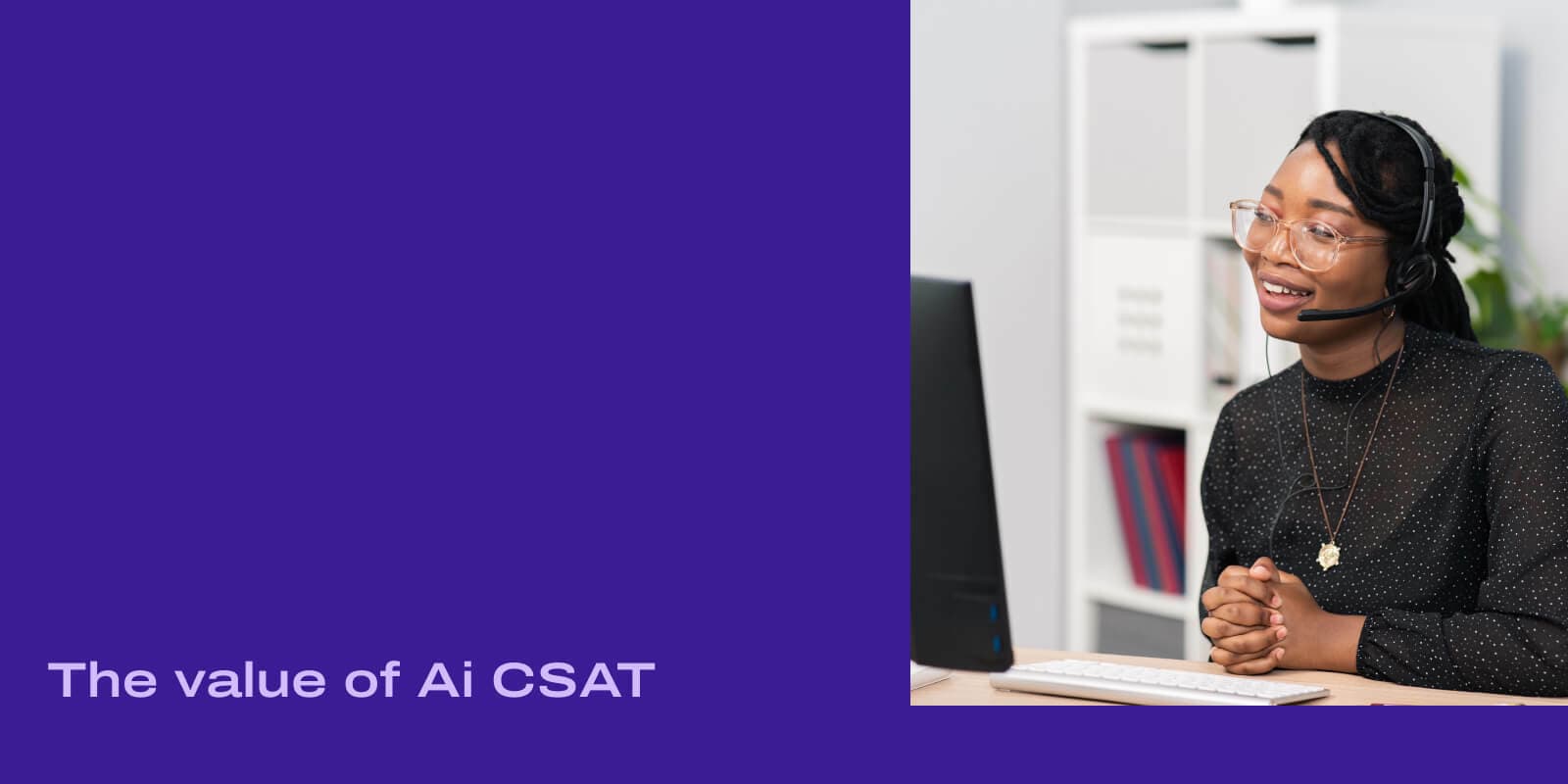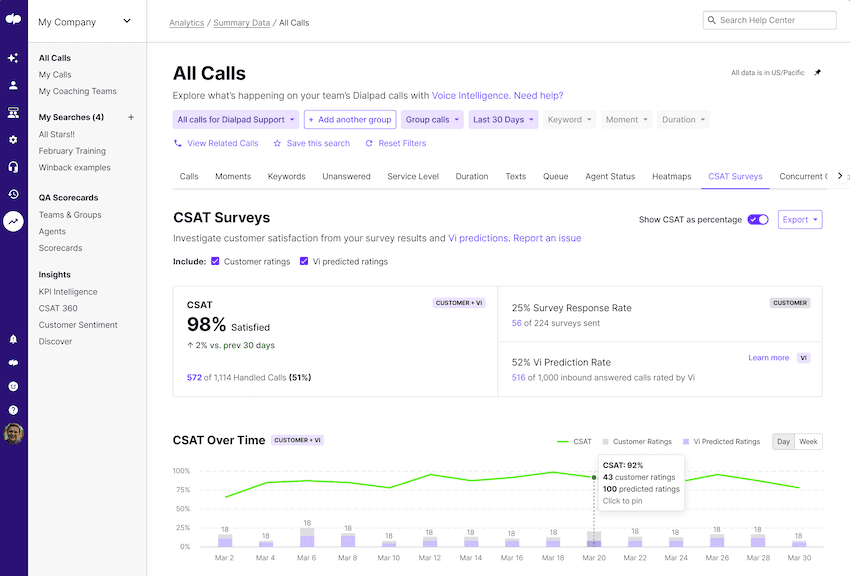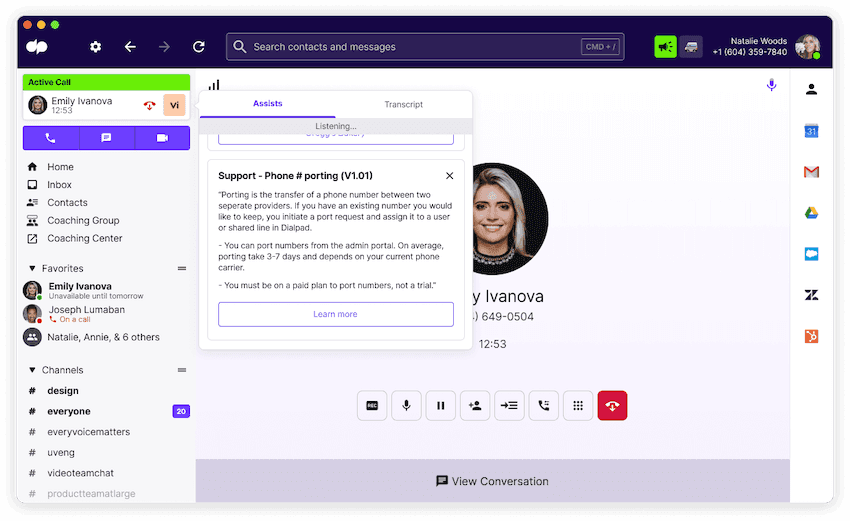
Tags
Share
When you’re dealing with mountains of data, it’s not always easy to sift through the numbers and find the truth about your customer experience.
Sure, traditional CSAT surveys give you insights that translate to star ratings or a read on sentiment, which can certainly be helpful. But technology has a role to play in turning that data into the knowledge you need to make strategies.
Ai CSAT uses predictive customer satisfaction scoring to refine your organization’s operations to be more efficient — without only relying on survey response data (which are typically fairly hard to gather, simply because many customers don’t respond to surveys).
Bringing Ai into your analysis makes it easier to collect data, and use that data to tell a more holistic story that will inform your decision making. This results in a deeper knowledge base for your entire team.
Specifically, there are three ways in which Ai CSAT provides better customer satisfaction data for contact center teams:
3 ways Ai CSAT can help you “see the whole iceberg” (of your customer satisfaction feedback)

1. It gives you a more accurate overall CSAT
One of the main advantages of Ai CSAT is the fact that the data is automatically collected over the course of a call. Ai CSAT analyzes the entire conversation from the perspective of the customer, which includes all the words that the customer would have heard or spoken.
Using an advanced deep neural network, Ai CSAT measures the satisfaction of the customer through the actual words being spoken and the turns taken with the agent — while continuously learning about how well the agent helped the customer.
All that data provides a more holistic look at what went right during a call, and where improvements can be made. Because that data is gathered during the call itself, there are no friction points to overcome, and no extra follow-up needed. Any survey you choose to send out post-call can provide additional insight — but it won’t be the only data available to you.
2. It gives you a bigger sample size
When you do a survey, you’re measuring only a sample of your audience, which requires you to later infer from the data what might be best for your entire audience. This leaves room for error. It also means there’s a chance your representative sample is missing out on the perspective of key demographics.
The automated nature of Ai CSAT ensures you get a 100% read, which means you’re constantly learning about your customer base as a whole, rather than making guesses about what’s true based on a small sample size. The larger your sample size, the more accurate your reading, which ultimately gives you a solid foundation from which to make decisions.

3. It reduces dominating polarized responses
Typically, those who complete surveys are on the polar ends of the satisfaction spectrum — really happy, or really upset. With Ai CSAT, you’re not self-selecting for those people or painting a curated picture of your customer experience because you have oversight of every moment of every call.
A survey that’s complemented by Ai CSAT brings that one-to-five rating into the context of the call itself, making the feedback more robust and actionable. This kind of technology also levels the playing field when tracking the performance of your support agents.
Even if some agents aren’t as persuasive when it comes to encouraging customers to leave CSAT feedback, they won’t be at a disadvantage thanks to Ai CSAT.
⭐ Bonus benefit: It provides information — in real time
Waiting for surveys to be collected and analyzed means missing out on opportunities to coach for improvement in the moment, or to share moments of success across your team. Ai CSAT is available for you just seconds after the call, so you can react immediately to situations and optimize customer health.
And once you’ve found patterns that are causing low CSAT scores, Dialpad lets you coach your agents — at scale — with its Real-time Assist (RTA) card feature, which can pop up tailored notes on agents’ screens when tricky topics come up on calls:

There are also “Custom Moments,” which let supervisors track keywords or phrases (like “refunds” or “pricing”), and can help support a contact center’s knowledge base.
This tangible information empowers employees to follow best practices in ways that feel natural to them, which can improve performance and job satisfaction simultaneously. Similarly, if there’s a burning topic you see coming up over and over in real time, you don’t need to wait until the end of the month to take action on it — you can make a change to your customer experience that same day.
Ready to get started with Ai CSAT?
Data is only useful once you’ve had a chance to accumulate it, organize it, and see its trends. With the context that Ai CSAT offers, you’ll be able to drill down into issues to make more sophisticated observations: What is the best answer to this question we hear a hundred times a day? Who is giving the best answers? Where should we focus our time?
Want to see how Ai CSAT works?
Book a product tour to get a personal walkthrough!

